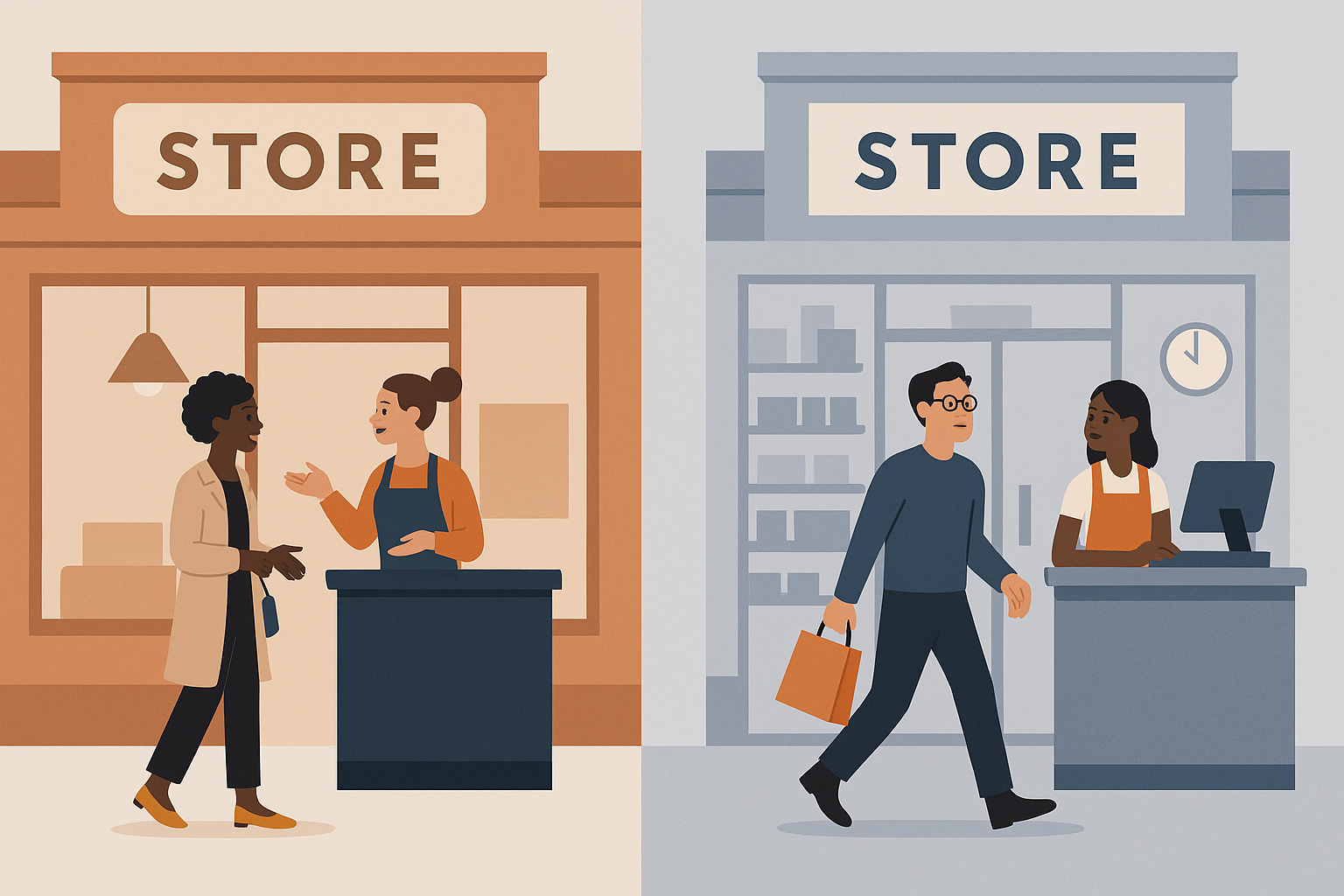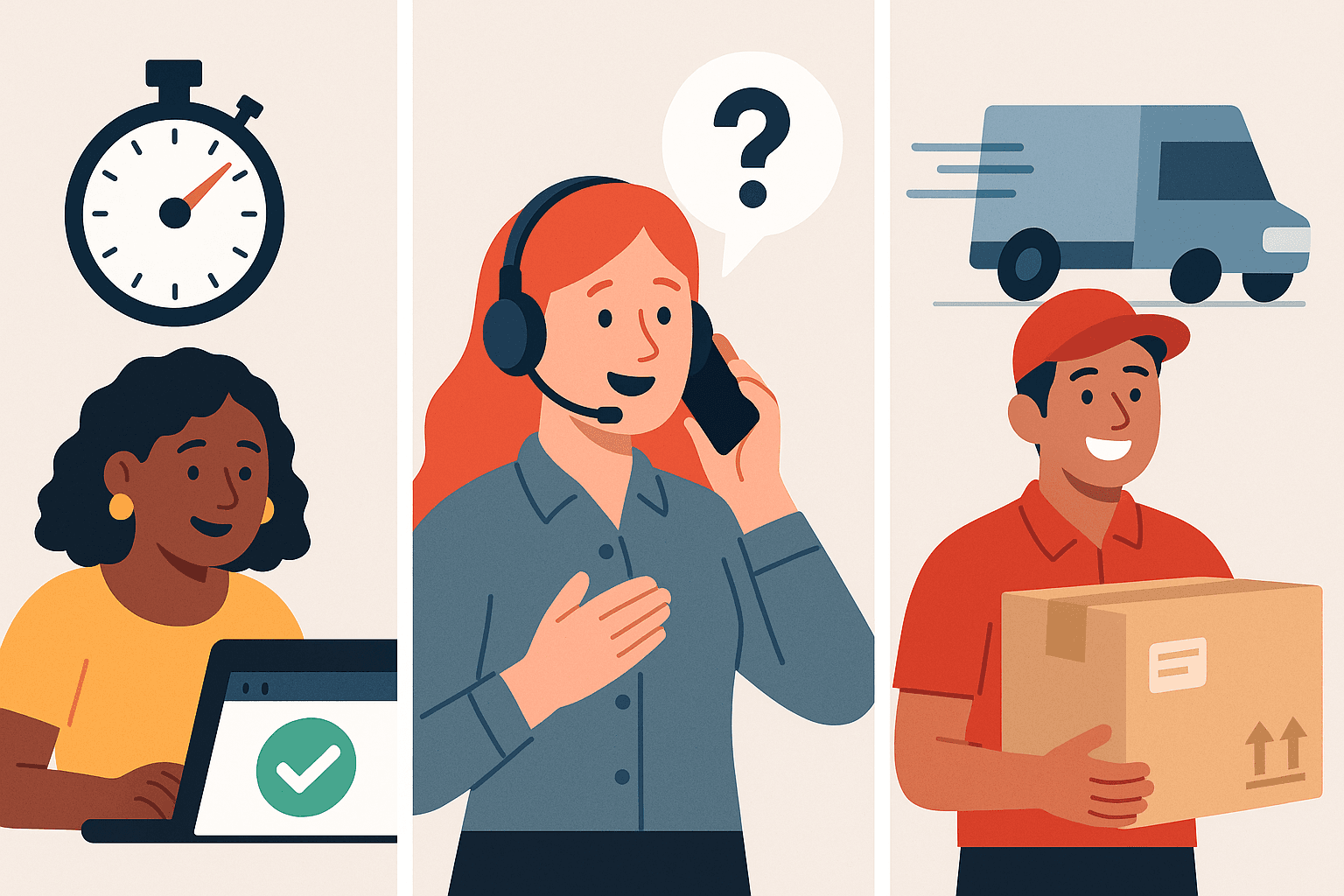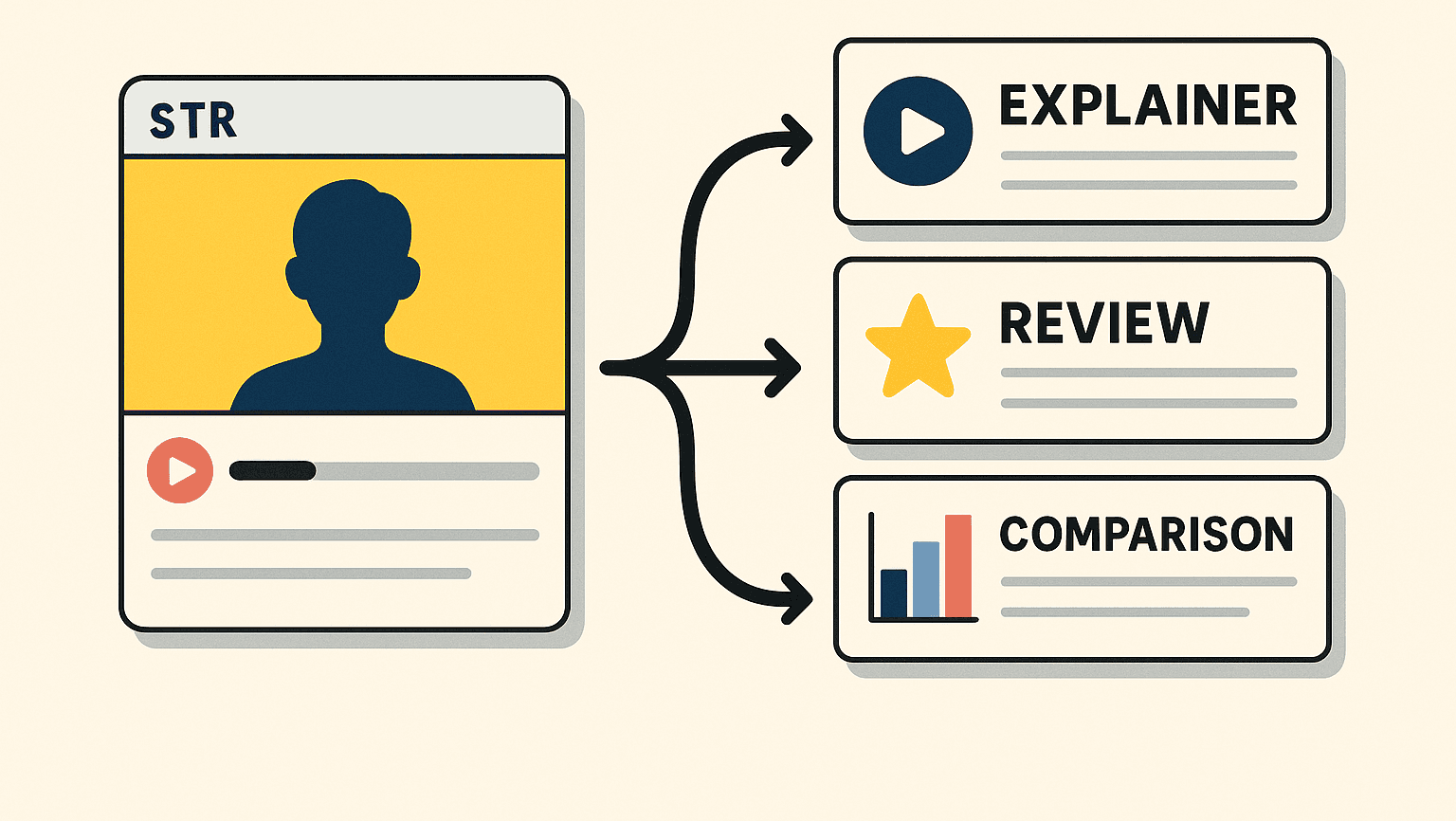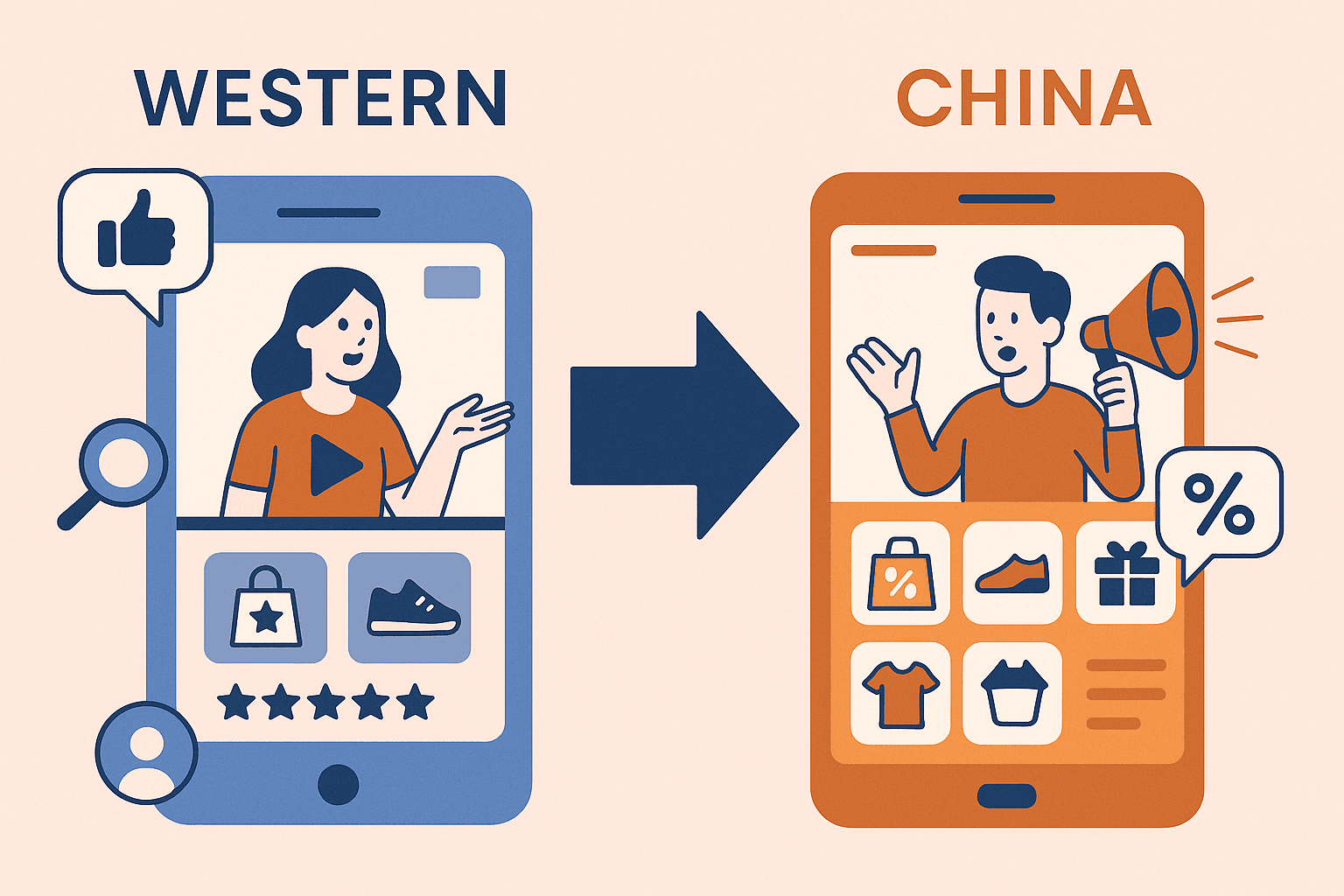Your Store Is a Destination—or a Depot. Choose.

TL;DR
- Physical still matters—just differently. Stores raise confidence (try, advice) or remove friction (BOPIS, returns).
- Pick a lane and design for it. Destination = service & story; Depot = speed & clarity.
- Measure what the lane should affect. Confidence metrics or last-mile KPIs—not generic footfall.
Why This Matters Now
If ecommerce ate convenience, physical retail still owns confidence.
The catch? Most brands haven’t decided which game their stores are playing.
Today’s winning retailers don’t treat stores as one-size-fits-all boxes—they treat them as nodes in the customer journey.
A store can either:
- Build emotional trust through experience (Destination), or
- Deliver operational ease through fulfillment (Depot).
Trying to do both in one space is like running a yoga studio and a DHL warehouse in the same building. You’ll confuse your customers—and your staff.
The Two Lanes of Modern Retail
1. The Destination Store: Where People Go to Feel Something
Destination stores are built for confidence and connection.
They exist to make people say, “I could’ve bought this online, but I came here because it felt right.”
These are the stores where:
- Staff act like guides, not cashiers.
- The floor plan feels like a story, not a stockroom.
- You leave remembering how it made you feel, not how long the queue was.
What to prioritize:
- Design for immersion. Every sense counts—lighting, layout, scent, even playlist tempo.
- Hire for empathy, not just efficiency. People buy from people who seem to care, not just scan barcodes faster.
- Use data to inform, not interrupt. Tablets should enhance storytelling, not remind shoppers of the checkout button.
The goal here isn’t volume—it’s value density: fewer transactions, higher loyalty, stronger advocacy.
(A natural companion read: Loyalty That Changes Behavior)
2. The Depot Store: Where Speed Is the Experience
The Depot model flips the emotional equation.
Its purpose? Minimize friction.
Think pickup points, same-day fulfillment, or hyper-efficient “grab-and-go” layouts.
Shoppers in this mode already know what they want. They’re not here to discover.
They’re here to confirm, collect, and continue their day.
What to prioritize:
- Fast lanes for known items. Make “order online, pick up in 10 minutes” your new billboard.
- Inventory accuracy as a promise. Few things ruin trust faster than “out of stock” after confirmation.
- Visible convenience cues. Clear signage, tight SKU curation, mobile pay stations—everything whispers “easy.”
Your Depot is the physical twin of your best-performing landing page: short, sharp, and optimized for action.
(Related read: Speed Is a Feature: Site, Support, and Delivery That Convert)
The Middle Is Where Margins Go to Die
Retailers that blur these two lanes end up doing neither well.
A “sort-of destination” confuses customers:
“Wait, am I supposed to browse or grab and go?”
A “half-depot” frustrates them:
“This is supposed to be fast—why am I waiting for someone to find my order?”
Pick one lane per location.
It’s better to have one clear promise executed perfectly than two promises delivered halfway.
How to Choose Your Lane
Step 1: Audit Behavior, Not Belief
Look at what your customers actually do, not what you wish they did.
Are they browsing for inspiration or collecting confirmed carts?
Are they asking questions—or just scanning QR codes?
Step 2: Match Design to Decision Mode
- Destination = more room for conversation, demo zones, sampling.
- Depot = streamlined flow, minimal distractions, visible efficiency.
Step 3: Align KPIs to the Lane
- Destination metrics: Confidence, NPS, repeat visit intent, brand recall.
- Depot metrics: Pick-up time, repeat rate, fulfillment accuracy.
Footfall is a relic of the pre-digital age.
Measure what the store’s purpose should influence.
What to Do This Month
- [ ] Label each store as Destination or Depot based on customer behavior.
- [ ] Align staff roles: storytellers vs. specialists.
- [ ] Rework the layout: immersion flow vs. efficiency flow.
- [ ] Integrate digital tools accordingly (appointments for Destination, live inventory for Depot).
- [ ] Rethink local media: “Come explore” for one, “Pick up faster” for the other.
Evidence & Caveats
BCG and Bain retail analyses show that stores with clearly defined roles outperform “multi-purpose” formats by up to 25% in margin growth.
Customers crave clarity—especially post-pandemic, where trips are intentional.
They’re either in experience mode (want to explore) or efficiency mode (want to get out fast).
Confuse those, and you’ll lose both.
FAQs & Objections
Can a store be both?
Technically, yes—but not at the same time.
If you run a chain, different formats can serve different roles.
But any one store should have one clear “job” in the journey.
What if our audience wants both experience and convenience?
They probably do—but they want them in sequence, not simultaneity.
Let your website handle convenience and your flagship handle connection.
Isn’t omnichannel supposed to unify everything?
Yes, but unity doesn’t mean uniformity.
Omnichannel works best when every touchpoint plays to its strength.
What happens if we don’t choose?
You’ll end up with mediocre experiences and mediocre economics.
It’s like designing a car that’s also a boat: impressive in theory, clunky in practice.
Key Takeaway: Choose with Courage
The store is no longer a default—it’s a design choice.
Choose the role it should play in your customer’s story and make every inch of it support that promise.
If it’s a Destination, make it emotional theater.
If it’s a Depot, make it operational ballet.
Because in modern retail, the question isn’t “Do stores still matter?”
It’s “Does your store know what it’s for?”
(And if you’re still holding brainstorming sessions under fluorescent lights in the stockroom—start there.)
Read similar content
Similar topics

Speed Is a Feature: Site, Support, and Delivery That Convert
Operational speed—page loads, helpful support, clear delivery—now decides who wins the cart.

Loyalty That Changes Behavior (Not Just Points)
Design rewards and service advantages that make people act differently—return more, spend more, advocate more.

Creators as the New SEM: Build Searchable Trust, Not Just Impressions
When creators become media channels, brands win by making their content discoverable, trustworthy and measurable—not just viral.

Design for Stream→Search: Sequencing Content That Survives the Algorithm
Why brands need content ladders that move people from passive scrolling to active searching—and how to build sequences that compounding attention.

Beyond #Ad: Why Affiliate + Long-Term Creators Are Eating Paid Social
One-off influencer posts are dying; long-term creator relationships and affiliate engines now outperform traditional paid social.

Social Commerce Is Growing Up: What to Copy (and Not) from China
Western social platforms are finally maturing into real shopping ecosystems—but China’s playbook isn’t a template, it’s a teacher.